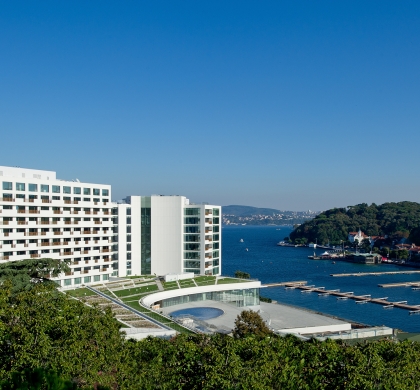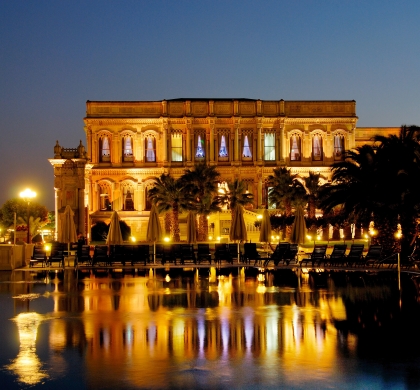Buy or gift a stand-alone digital subscription and get unlimited access to dozens of back issues for just £18.99 / $18.99 a year.
Please register at www.exacteditions.com/digital/cornucopia with your subscriber account number or contact subscriptions@cornucopia.net
Buy a digital subscription Go to the Digital EditionAlice Greenway went to Istanbul to study Turkish and learnt to love swimming in the Bosphorus while she was at it
KUZGUNCUL PLAJI
‘We need to get you into the Bosphorus.’ The Ottoman scholar and Cornucopia correspondent Caroline Finkel takes charge, making a date to meet at the local Kuzguncuk plaj. I’m thrilled. I am one of those people who are addicted to swimming and find it hard to pass any inviting body of water without launching myself in. By the following week I’m registered to swim in 2013’s annual Bosphorus Cross-Continental Swimming Race. But, stepping down from the crumbling sea wall onto a wet, weedy rock, I find myself on the edge of a raging current. Up close, the Bosphorus rushes past in eddies and ripples, washes around my ankles and slaps hard against the shore. ‘Aren’t you going in’ Caroline asks.
Having recently waymarked a long-distance trail following the hoofprints of the great 17th-century Ottoman traveller Evliya Çelebi, Caroline is now trailblazing walks in the outskirts of the city – a bid to make Istanbullus aware of their countryside before it disappears.
I hate to disappoint. But the only current I have swum in that comes close is a tidal river in Massachusetts where my nephew once got swept out to sea and had to be rescued by kayakers. I peer downstream. If I am pulled out by the current here I’ll be carried down through the busy ferry traffic at Üsküdar, right past the Maiden’s Tower, and out towards the Sea of Marmara.
Luckily for me, Caroline has brought along another friend, the former journalist Aygül Özkaragöz, who spent her childhood summers in Kuzguncuk and used to swim from the rıhtım (quay) in front of her yalı (waterfront house). If you stick close to the foundations of the yalıs, Aygül demonstrates, there is a slight back current. I jump in to follow her, swallowing mouthfuls of Bosphorus sent in by the swell of a passing container ship. We manage to swim up two weedy house-lengths before being swept back down.
Just then, to my delight, two skinny boys come by, floating fast downstream, followed shortly by two more boys with an inner tube. Cheerily they kick in to take a short rest, eye us with curiosity, before launching themselves back downstream. Twenty minutes later, we see the same boys walking back up along the road in bathing suits and bare feet, carrying the inner tube. When I look up, a huge, dark-grey submarine is making its way midstream towards the Black Sea. Because of the tricky currents, submarines are forced to surface when travelling up and down the strait.
The Kuzguncuk plaj (or beach, from the French plage) is a dusty plot of land that slopes down to the strait – just a short walk upstream from the famed İsmet Baba fish restaurant. It is bordered on one side by a house, while on the other a stone wall topped by a wire fence juts out into the water, protecting against the north wind and current and providing a place where swimmers can hang their clothes from a single strand of barbed wire.
This Friday two women sit in the shade of two trees picnicking while their children, boys and a girl, dabble in a shallow pool dug amongst the weedy rocks. They offer us Fanta and simit when we come out of the water.
Now a large, smiling, effusive man in a red bathing suit is standing out on the rock at the end of the stone wall, making large circular movements with his arms. The plaj has its own particular eddy, he says. If you swim upstream, then directly out into the strait, this eddy will carry you back in. Putting one arm forward and one against his side, he dives in to demonstrate. A retired restaurant worker, Orhan spends most days here, swimming and sunning and looking after the place. He digs out the shallow swimming hole, scrapes the weed off the rocks, picks up glass from broken beer bottles and cleans mussels. He parks his 1970s olive-green Mercedes at the edge of the road. “You can tell a lion from where he sleeps,’ he boasts.
No one is sure who owns this plot of land or why it remains empty. ‘Perhaps the city owns it, perhaps the nearby Armenian church has a share. Perhaps it’s a disputed piece of land,’ Orhan says. It has served as the local beach for at least 50 years. Born and raised in Kuzguncuk, he remembers when Üsküdar had its own sandy beach near the lighthouse and there was a single tramline coming up the coast. He and the other boys would swim down, then run and hang on to a moving tram to catch a free ride back up.
And yes, Orhan says, it’s good that women come to swim here. He promises to keep unruly boys in order. ‘Now you have a friend and lifeguard,’ Caroline informs me contentedly.
TWO CONTINENTS, ONE RACE
Despite this initiation, it is with some alarm that I find myself, early the following Sunday, dressed in bathing suit and numbered cap – 319 – filing along with hundreds of other swimmers onto one of the two ferries that will take us up the Bosphorus. We have been issued with disposable, hotel-style slippers. Electronic tags Velcroed to our ankles will clock our times.
July is the hottest month in Istanbul and I am already feeling dehydrated and anxious. Although practised in ‘wild swimming’ as it is now called, I’ve never in my life taken part in an organised sporting event. As the engines start, a welcome breeze wafts through. Someone shouts and chants go ricocheting between the two boats. ‘Her yer Taksim. Her yer direniş.’ Everywhere Taksim. Everywhere resistance, swimmers shout in support of the protests that had shaken Turkey recently – sparked by government plans to bulldoze a beloved park at Taksim Square. Other slogans I am learning that summer are özgürlük (freedom), and boyun eğme (don’t bow your head).
The Bosphorus Cross-Continental Race, celebrating its 28th year in 2016, began informally in 1988, when 64 men and four women from a local swimming club raced the narrowest stretch: 700 metres from Anadoluhisarı to Bebek. Today it is run by Turkey’s Olympic Committee and more than 1,500 swimmers from all over the world participate. This morning, with all shipping put on hold for three hours, we will swim 6.5km, from the pretty town of Kanlıca on the Asian side, just north of the Fatih Sultan Mehmet Bridge, down to Kuruçeşme Park in Europe – places I’m still having trouble pronouncing…
Two weighty tomes on the glories of Iznik pottery. Tim Stanley reviews the magnificent new Iznik book cataloguing the stupendous Ömer Koç Collection and a new study of Iznik’s Damascus offshoot.
Last Christmas, the art historian Francis Russell escaped the festivities for a hectic week revisiting the Aegean’s most fascinating historic sites, in readiness for a new, enlarged edition of his guide ‘Places in Turkey: A Pocket Grand Tour’. Here is his diary of an action-packed week
The fine art photographer Brian McKee left Istanbul last July to explore the fabled sights of eastern Turkey. Renting a flat in the city of Van, he pored over a weighty survey by the scholar TA Sinclair and followed in his footsteps for 3,000 magnificent kilometres, around Lake Van, and north as far as the old Iron Curtain
Oozing delicious juices, irresistibly moreish, the ‘tirit’ covers a range of traditional Turkish soups and stews, both savoury and sweet, with slices of bread at their heart. Berrin Torolsan serves up the ultimate in comfort food
Visitors arriving by water at the sultans’ pavilion of Küçüksu Kasrı could scarcely believe their eyes. As the gates on the Bosphorus swung open, they entered a world of head-turning theatricality, beauty and embellishment – a Dolmabahçe Palace in miniature that charmed a prince. By Berrin Torolsan. Interior photographs by Fritz von der Schulenburg
Istanbul, straddling two continents and sandwiched between two seas, has a thrillingly varied flora which includes many plants seen nowhere else on the planet. Sadly, it is also critically endangered. Text and photographs by Andrew Byfield



Cornucopia works in partnership with the digital publishing platform Exact Editions to offer individual and institutional subscribers unlimited access to a searchable archive of fascinating back issues and every newly published issue. The digital edition of Cornucopia is available cross-platform on web, iOS and Android and offers a comprehensive search function, allowing the title’s cultural content to be delved into at the touch of a button.
Digital Subscription: £18.99 / $18.99 (1 year)
Subscribe now